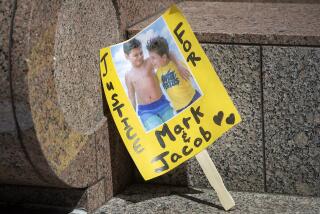Weller’s Absence Plays Uncertain Role in Trial
- Share via
For more than three weeks, a jury has heard testimony about George Weller, the old man who plowed his car through the Santa Monica Farmers’ Market in 2003. They saw gruesome photos and heard about the 10 people he killed with his maroon 1992 Buick. They saw a two-hour tape of Weller’s interview afterward with police.
What they have seen very little of is Weller himself, now 89, in a wheelchair and said to be in deteriorating health and under increasing stress. He will not be there to hear the verdict. Over the prosecutor’s objections, the defense won permission to keep Weller out of court -- because he’s too ill -- and beyond the view of the 12 people who began Friday to deliberate his fate on 10 counts of manslaughter.
Weller missed witnesses who wept openly in court when asked about the carnage at the farmers market, others who interpreted his reaction as unconcern, and one who still seemed as ready to call for the senior’s lynching as he did on the day of the tragedy, when more than 60 people also were hurt.
Weller missed huge blowups of photos of the dead and injured, except for one, which was shown the one day he attended the trial. It showed a corpse on the windshield and a body under the wheels of his car after it came to rest along Arizona Avenue on July 16, 2003. Weller’s lawyers say he committed a horrible accident; he meant to step on the brake but instead hit the accelerator and was too panicked to correct himself -- something known as “pedal error.”
Experts say Weller’s absence in court was either an error, or a stroke of tactical genius. Criminal defendants often avoid testifying, but nonattendance is rare.
“In most cases, lack of a defendant is a huge disadvantage to the defense. Without a face, it’s a lot harder for jurors to feel sympathetic, and a lot easier for them to give a harsh penalty,” said Ken Broda-Bahm, president of the American Society of Trial Consultants and an expert with the firm Persuasion Strategies.
Since most criminal defendants do not testify, their demeanor can be a key to jury perception. For instance, defendants fight to be allowed to wear street clothes, rather than jail garb, in the courtroom. In one recent trial, prosecutors showed blowup pictures of four defendants that revealed gang tattoos covering their torsos, otherwise invisible in court.
Broda-Bahm said Weller’s absence depersonalizes the case -- which may be what the defense is calculating. The Weller case has prompted the state Legislature and Department of Motor Vehicles to work harder to identify drivers who pose a danger to others, and it has sparked a continuing debate on how best to license aged drivers.
“This subtly sends the message that this isn’t about George,” Broda-Bahm said. “It’s less of a personal issue.”
Joellen Dimitrius, a prominent consultant who worked for the defense in the O.J. Simpson trial, said a jury is denied certain information without a defendant present.
“What jurors look at is body language, not only on the stand, but when they’re sitting in the courtroom,” Dimitrius said. “That may be one of the reasons why he’s not sitting at the counsel table.”
Jurors consider how a defendant relates and reacts not only to the defense counsel but to everything in the courtroom.
“The courtroom becomes the home for the jury,” Dimitrius said. “They look and watch everyone who walks into their home -- the defendant, the judge, or someone in the audience. They make assumptions based on their interaction with people in the courtroom.”
But jurors have listened to Weller. Deputy Dist. Atty. Ann Ambrose showed a secretly made two-hour videotape of his interrogation by Santa Monica police within hours of the deaths. That focuses attention even more directly on the tape, experts agreed.
“In essence, the defense has made a strategic judgment that the tape presents their client as rational, coherent, in contact with reality and not under the obvious influence of any intoxicant,” said UCLA law professor Peter L. Arenella. “He shows apparent remorse while also insisting he did everything possible to avoid this tragedy. That’s the defense’s underlying theme.”
“Because that is the only exposure, it’s going to be really tightly scrutinized,” Broda-Bahm said. “A jury is an amazing thing. Individual jurors might miss things, but collectively, the jury misses nothing. I would expect them to really examine that tape for any indication of attitude.”
Jurors could conclude that because Weller made the statement before he had been groomed by attorneys, it might be the best evidence of his demeanor. Broda-Bahm said they will look “for signs, not of the facts, for signs of his attitude toward the event.”
“Is this the way a person talks about an accident? Or is it the way he talks about a crime? How much remorse is there, and how genuine is it?” Broda-Bahm said.
How do jurors distinguish between gross negligence and misdemeanor negligence, and noncriminal negligence?
“It’s a matter of chance,” said Stephen Garvey, a professor of law at Cornell University, who has written extensively about crimes of negligence. “Some argue that if there’s no intent to cause an injury, it’s an accident. What separates criminal from civil negligence is not very satisfying. There must be gross negligence. I don’t know what that term means.”
Defining the concept of a gross deviation from the standard of care is hard, even for trained lawyers. Garvey said the next person to press the accelerator may hit nothing but a tree on a dead-end street, but suggested that the act itself is little different from Weller’s.
“That’s why we have juries,” Garvey said. “That’s what people would say: Does it strike you as a case of gross negligence? I suspect with 10 bodies around, it might point toward finding gross negligence.”
Richard Gabriel, president of Decision Analysis, consultants with offices in Los Angeles and Chicago, said juries can represent “a really funny phenomenon.”
“The character of the defendant gets acted out. Jurors will re-create the actual accident; they are looking for things to solve the mystery. They are to a certain extent creating in their own minds, as it were, a videotape of what happened in that car. To do that, they’re taking the videotape evidence, but also are looking for other clues based on human nature.”
Jurors watched the two-hour videotape just once. But it came up a second time when prosecutors noticed a short omission in the version shown in court. The tape had been prepared by the defense and inadvertently omitted Weller’s impatient demand to know “how the hell am I going to get home if you’re going to impound my car?”
Ambrose, the prosecutor, pointed out that Weller made that comment -- amplified by being used separately -- while bodies were still lying on the pavement at the farmers market.
The jurors were instructed not to decide the case with pity or prejudice, but lawyers worry that other factors intrude. Many Americans have an aging parent or friend whose driving skills have deteriorated but who remains on the road.
The jury will resume its deliberations Tuesday. Jurors could acquit Weller; convict him on all felony counts, punishable by 18 years in jail; or convict him on any or all of 10 misdemeanor manslaughter charges. He could be jailed for up to a year on each count.
Dimitrius, the jury consultant, suggested that nullification could come into play -- the de facto power of juries to acquit a defendant regardless of the strength of the evidence against him. “They will consider the [evidence in the] case, but as came up at my breakfast table this morning, the question is: Are we taking care of elderly people in our society when it comes to their ability to drive?”
*
More to Read
Sign up for Essential California
The most important California stories and recommendations in your inbox every morning.
You may occasionally receive promotional content from the Los Angeles Times.













